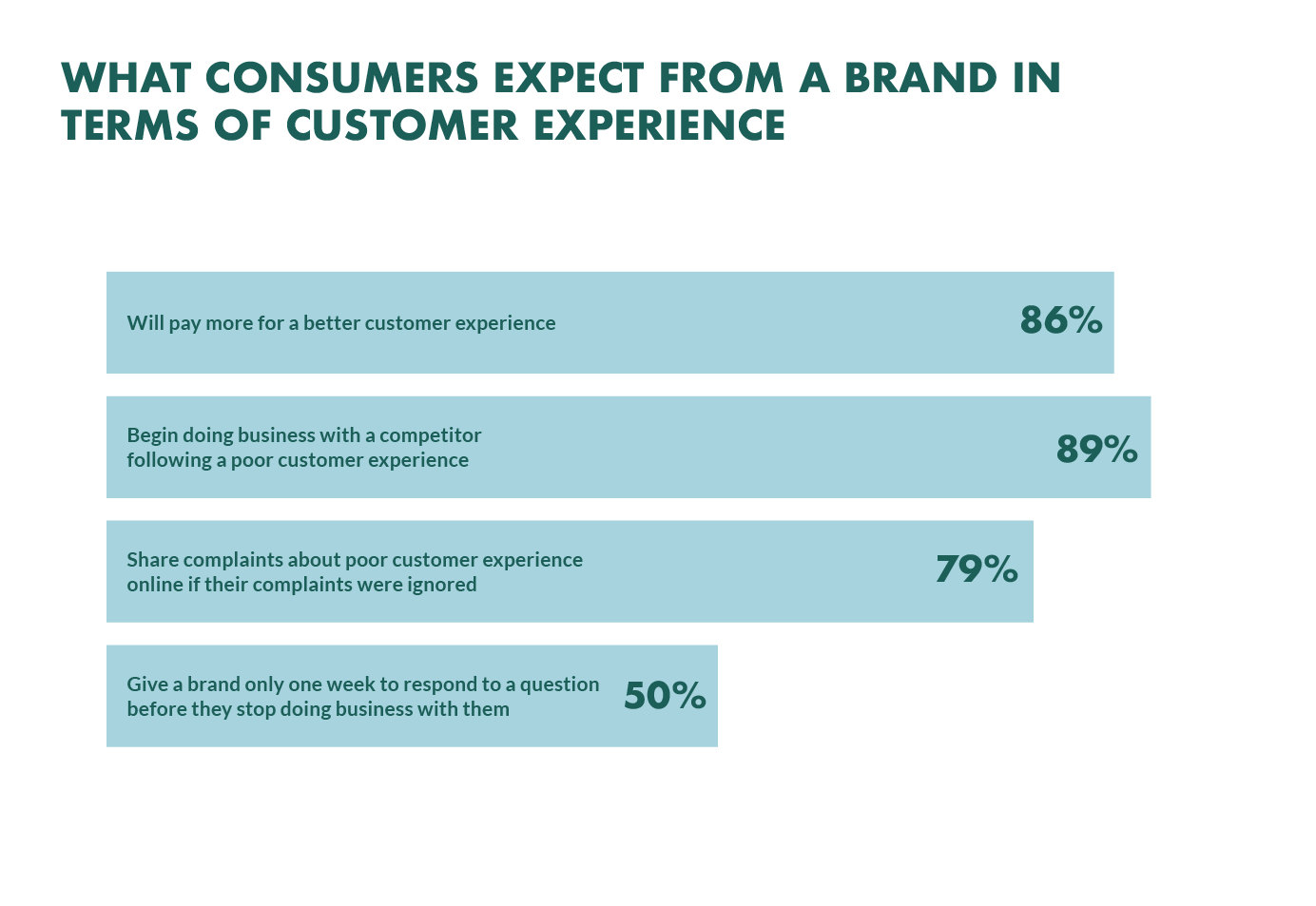There’s a reason customer experience has overtaken price and product as the top competitive differentiator.
It’s not just a trend - it’s a measurable growth lever.
The best CX leaders aren’t guessing what customers want. They’re listening to the data - and using it to design smarter, faster, more personal experiences across every touchpoint.
In this report, we’ve pulled together the most current and compelling CX statistics to show exactly how expectations are changing - and what top-performing companies are doing about it.
Let’s dive in.
Why CX = Growth
Customer experience is a proven growth driver.
Companies that lead in CX grow revenue 80% faster than their competitors. Why? Because great experiences turn first-time buyers into loyal customers, loyal customers into advocates, and advocates into your lowest-cost marketing channel.
- 86% of buyers say they’ll pay more for a better experience - especially in high-consideration B2B categories
- Customers who rate their experience a 10/10 spend 140% more and remain loyal up to 6x longer
- But get it wrong? 1 in 3 customers will leave after just one bad interaction
The message is clear: if you want higher retention, higher lifetime value, and more sustainable growth - start with CX.

Want to see how leading companies are turning CX into real revenue?
Explore the SuperOffice CRM platform to see what’s possible when every team has the full customer picture.
What Modern Buyers Expect
Today’s customers aren’t just comparing you to your competitors - they’re comparing you to the best experience they’ve ever had. That means fast, personalized, and consistent service across every touchpoint.
Here’s what they expect by default: ●
- 71% expect personalized experiences but feel frustrated when they don’t get them
- 90% say an immediate response is important when they have a question
- 73% expect seamless journeys across all channels and devices
If your teams don’t have full context or your systems don’t talk to each other, the customer feels it. And in 2025, they won’t wait around while you catch up.
Modern CX is about removing friction, anticipating needs, and making every interaction feel effortless.
Why Most Companies Still Miss the Mark
Everyone says CX is a top priority - but most fall short when it counts. Why? Because delivering great experience at scale is hard.
Here are three common blockers:
1. Siloed Systems
Customer data is scattered across tools. Sales sees one version of a customer. Support sees another. That leads to delays, repetition, and generic experiences.
2. Outdated Processes
Manual workflows, clunky handoffs, and slow response times frustrate customers - and burn out teams.
3. Tech Without Adoption
Even the best tools fail if no one uses them. When reps avoid the CRM or skip logging data, the whole CX engine breaks down.
In short: good intentions aren’t enough. Operational gaps create real friction - and your customers notice.
The CX Execution Gap
Everyone wants to be customer-first. But most companies still operate like it's 2015.
Teams say CX is a priority - but run on siloed tools, scattered data, and reactive processes. They launch surveys but never act on them. They roll out software but skip the training. They tell reps to be personal - but don’t give them the context to do it.
The result? Inconsistent experiences that frustrate customers and exhaust teams.
And the worst part?
Many leaders don’t realize there’s a gap - until customers churn or growth stalls.
To close it, you need more than intention. You need infrastructure.
Most companies don’t fail because they don’t care — they fail because their systems can’t keep up. Book a demo of SuperOffice and see how to fix CX friction where it actually starts.
The Data Behind Great CX: What Customers Really Want
Customers won’t always tell you what they expect - but the data speaks loud and clear. These CX statistics reveal how experience impacts behaviour, loyalty, and revenue.
Experience = Revenue
- 73% of consumers say experience is a key factor in purchasing decisions - second only to price and product.
- CX leaders grow revenue 80% faster than competitors.
- Customers are willing to pay a 16% premium for great experiences - especially in B2B and service categories.
Expectations Are Higher Than Ever
- 90% of buyers say “immediate response” is crucial when they have a support question.
- 1 in 3 customers will leave a brand they love after one bad interaction.
- Only 8% of customers think companies deliver “excellent” CX - while 80% of businesses think they do.
Loyalty Is Earned - or Lost
- Customers who rate a company’s CX 10/10 are 6x more likely to repurchase.
- Happy customers tell 6+ people about great experiences.
- Unhappy customers rarely complain - they just leave. Only 1 in 26 actually say something.
The takeaway? Experience isn’t a “nice to have anymore” It’s the reason people buy - and stay.
These stats are more than insight - they’re a call to act. Not sure where to start? Talk to a CX expert and map out what better could look like for your team.
What the Data Really Means
These stats don’t just confirm that CX matters - they signal a major transformation in how people buy, stay, and spend.
In the past, great service was a differentiator. In 2025, it’s the baseline.
Today’s buyers aren’t loyal to brands - they’re loyal to experiences. They expect instant answers, personalized interactions, and seamless transitions across channels. They don’t tolerate delays, repetition, or being treated like a ticket number.
And they’re not afraid to leave when those expectations aren’t met.
The message is clear: customer experience isn’t just about satisfaction. It’s about survival.
So what sets them apart?
The CX Operating System of Top Performers
High-performing teams don’t just aim for great experiences - they engineer them. This is the tech stack that makes it repeatable at scale.
Unified Data Layer
Everyone - from sales to service - sees the same up-to-date customer history, preferences, and behaviour. Teams using CRM hit quota 41% more often.

Smart Automation
AI handles routing, follow-ups, and alerts - so reps can focus where it counts. AI-powered CX resolves issues 30% faster and boosts satisfaction by 21%.
Real-Time Feedback Loops
Surveys trigger action, not just reports. Feedback is linked to actual behaviour. Companies that connect feedback to CRM improve NPS 3x faster.
Contextual Enablement
Reps don’t dig for data. It’s surfaced automatically - so they know who they’re talking to, what matters, and what to do next. Strong omnichannel engagement = 25% higher close rates and 10% higher order values.
This is what modern CX infrastructure looks like. And it’s what separates leaders from everyone else.
From Insight to Action
Customer experience isn’t just something you analyze. It’s something you build - deliberately, consistently, and at scale.
The data is clear:
Customers reward companies that make every interaction feel effortless.
They stay longer, spend more, and tell others.
But great CX doesn’t happen by accident. It takes the right systems, the right insights, and the right tools to make it repeatable.
The Cost of Inaction
Every missed follow-up. Every “just checking in” email with no context.
Every transfer that makes a customer repeat themselves.
They may seem small. But they add up - fast.
It all leads to:
- Lost trust
- Lost renewals
- Lost advocacy
In fact, most customers don’t even complain. They just leave. Quietly.
In a market where every experience counts, operational friction isn’t a minor inconvenience. It’s a revenue leak. And the longer it goes unchecked, the harder it is to win customers back.
The time to fix it? Before they walk away.
That’s where SuperOffice comes in.
Ready to Turn Insight Into Impact?
SuperOffice helps B2B teams close the gap between what customers expect - and what companies actually deliver. Because world-class CX isn’t built on guesswork. It’s built on the right systems, the right timing, and the right insight - at scale.
Talk to a CRM expert or book a personalized demo today to find out how SuperOffice CRM can help you build the experience your customers deserve.




